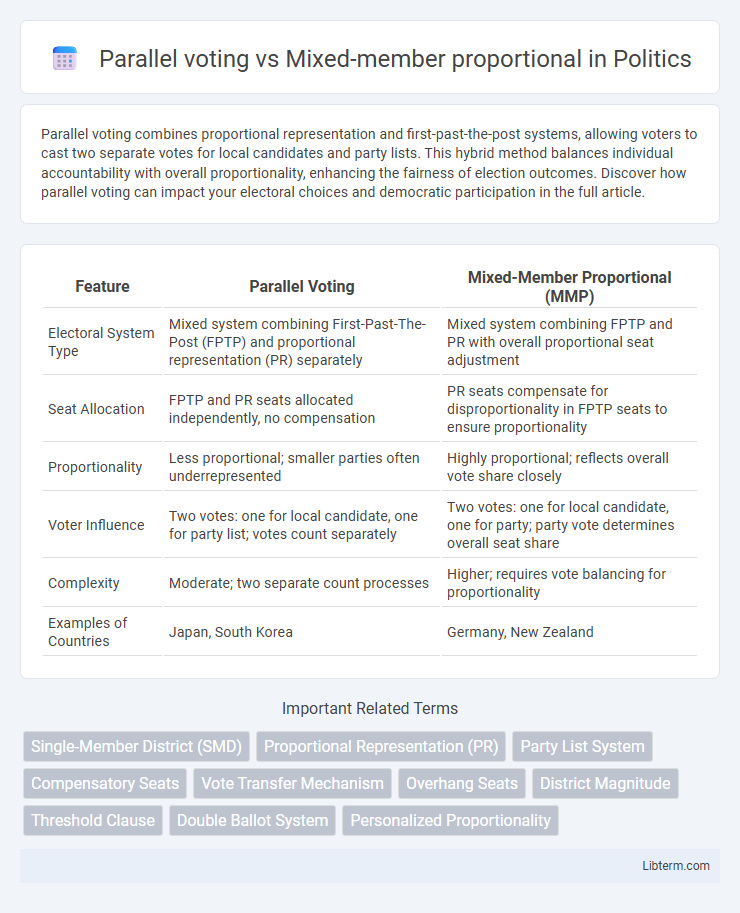Parallel voting combines proportional representation and first-past-the-post systems, allowing voters to cast two separate votes for local candidates and party lists. This hybrid method balances individual accountability with overall proportionality, enhancing the fairness of election outcomes. Discover how parallel voting can impact your electoral choices and democratic participation in the full article.
Table of Comparison
| Feature | Parallel Voting | Mixed-Member Proportional (MMP) |
|---|---|---|
| Electoral System Type | Mixed system combining First-Past-The-Post (FPTP) and proportional representation (PR) separately | Mixed system combining FPTP and PR with overall proportional seat adjustment |
| Seat Allocation | FPTP and PR seats allocated independently, no compensation | PR seats compensate for disproportionality in FPTP seats to ensure proportionality |
| Proportionality | Less proportional; smaller parties often underrepresented | Highly proportional; reflects overall vote share closely |
| Voter Influence | Two votes: one for local candidate, one for party list; votes count separately | Two votes: one for local candidate, one for party; party vote determines overall seat share |
| Complexity | Moderate; two separate count processes | Higher; requires vote balancing for proportionality |
| Examples of Countries | Japan, South Korea | Germany, New Zealand |
Introduction to Electoral Systems
Parallel voting combines first-past-the-post and proportional representation without compensating for disproportionality, allowing voters two separate ballots that influence legislative seats independently. Mixed-member proportional (MMP) systems use a compensatory mechanism to ensure overall seat distribution closely matches the party vote share, enhancing proportionality by adjusting list seats based on constituency results. Electoral systems like parallel voting often produce semi-proportional outcomes, while MMP aims to balance local representation and fair party representation, impacting government legitimacy and voter satisfaction.
Defining Parallel Voting
Parallel voting combines first-past-the-post and party-list proportional representation without interlinking seat allocation, allowing voters two separate ballots. Each component functions independently, meaning the proportional seats do not compensate for disproportionality produced by the majoritarian vote. This system contrasts with mixed-member proportional voting, which adjusts list seats to reflect overall party vote shares, ensuring proportional representation.
Understanding Mixed-Member Proportional (MMP)
Mixed-Member Proportional (MMP) combines single-member district representatives with party list seats to ensure overall proportionality in the legislature. Voters typically cast two votes: one for a local candidate and another for a political party, with party list seats allocated to compensate for disproportionality in district results. Unlike Parallel voting, which treats the two votes independently without proportional adjustment, MMP ensures that the total number of seats for each party reflects their share of the party vote, enhancing fair representation.
Key Differences Between Parallel Voting and MMP
Parallel voting combines single-member district winners and proportional party lists independently, resulting in a non-compensatory system where seat shares often do not match total votes. Mixed-member proportional (MMP) adjusts party list seats to compensate for disproportional results in district elections, ensuring overall proportional representation. Key differences include proportionality of outcomes--MMP delivers near-perfect proportionality whereas parallel voting maintains majoritarian advantages--and the way list seats are allocated either independently (parallel) or to achieve proportional balancing (MMP).
How Representation Works in Parallel Voting
Parallel voting divides the electorate into two separate votes: one for choosing representatives through single-member districts and another for party lists, where seats are allocated independently, leading to a non-compensatory effect. Each vote operates under distinct rules, so the overall seat distribution does not necessarily reflect the proportion of total votes parties receive, allowing majoritarian and proportional elements to coexist without adjustment. This system often results in a legislature with a blend of directly elected members and party-list representatives, but it can overrepresent larger parties compared to mixed-member proportional systems that aim for compensatory balance.
How Representation Works in Mixed-Member Proportional
Mixed-Member Proportional (MMP) representation combines single-member district representatives with party lists to ensure overall proportionality in the legislature, adjusting the total number of seats each party receives based on their share of the party vote. Constituency representatives are elected through plurality in local districts, while party-list seats compensate for disproportionalities, aligning the final seat allocation closely with the national vote percentages. This system prevents overrepresentation of winning parties, contrasting with Parallel voting where constituency and party-list seats are allocated independently without compensatory adjustments.
Advantages of Parallel Voting
Parallel voting offers the advantage of combining majoritarian and proportional representation systems without compensatory seat adjustments, allowing for straightforward ballot design and voter understanding. This system enables clearer local representation while maintaining overall proportionality in legislative bodies. Parallel voting reduces the complexity and potential distortion of mixed systems, ensuring a balance between constituency accountability and party-based proportionality.
Advantages of Mixed-Member Proportional
Mixed-Member Proportional (MMP) voting ensures more accurate representation of political parties reflecting the overall vote share, reducing wasted votes compared to Parallel voting. MMP combines single-member district accountability with proportional allocation of party list seats, enhancing both local representation and party proportionality. This system promotes a fairer balance between majoritarian and proportional principles, fostering broader political inclusivity and coalition governance.
Real-World Examples: Countries Using Each System
Japan and South Korea utilize parallel voting, combining first-past-the-post and proportional representation without compensating for disproportionality, ensuring both local representation and party-list seats. Germany and New Zealand employ mixed-member proportional (MMP) systems, where proportional seats compensate for disproportional outcomes from single-member districts, promoting overall party proportionality. These real-world applications highlight parallel voting's emphasis on majoritarian elements and MMP's focus on achieving proportional representation through seat adjustment.
Choosing the Right System: Factors to Consider
Choosing between Parallel voting and Mixed-member proportional systems depends on the desired balance between proportionality and local representation. Parallel voting combines separate majoritarian and proportional components without adjusting for overall proportionality, often favoring larger parties, while Mixed-member proportional adjusts list seats to achieve closer proportional results reflecting voter preferences. Key factors include the importance of proportional fairness, simplicity of the system, and the political context, such as party fragmentation and voter behavior.
Parallel voting Infographic

 libterm.com
libterm.com